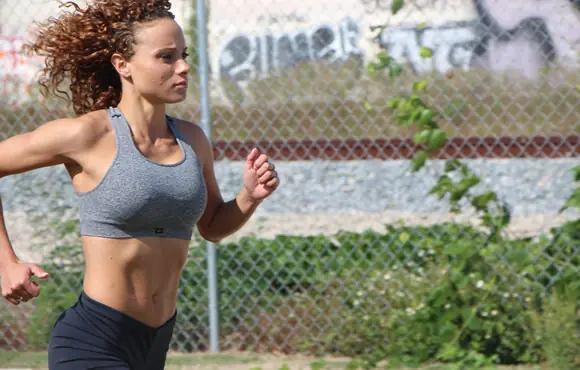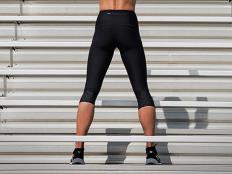But, obviously, women are different from men. The physiological and emotional differences between males and females mean that women must overcome different challenges to become the best runners they can be. This guide provides expert answers to the most frequently asked questions about running for women—from breast health to racing during menses to running during pregnancy.
How Female Runners Differ From Male Runners
1 of 19
Estrogen is the single biggest thing that differentiates you from the guy running next to you in a race. It is a powerful hormone, influencing many aspects of a woman's physiology, from metabolism to glycogen storage to lung function to bone health. A runner-friendly hormone, times of the month when estrogen is high (just before ovulation at the end of the follicular phase of your menstrual cycle and the middle of the luteal phase) are good times to focus on hard workouts and races.
—Jason Karp
Will Running a Race While on Your Period Slow You Down?
2 of 19
Studies suggest the best times to compete are the first couple days into your period or immediately after bleeding has finished. It is during this time that estrogen and progesterone are at their lowest, and are less likely to create any menacing changes.
Your body tries to spare glycogen during the luteal phase, or days 14 to 15 to 28 in your menstrual cycle. The surge in estrogen therefore stimulates the body to use fat more. If you're racing or training intensely during the luteal phase, you need to be extra conscious to make sure you're taking in at least 40 grams of carbohydrate per hour, says Dr. Stacy Sims of Stanford University.
The second factor to consider if racing during the luteal phase is the drop in your plasma volume. The blood becomes thicker when plasma volume drops and, as a result, blood moves more slowly between muscles. This results in slower recovery time.
—Amanda McCracken
How Your Metabolism Makes You an Awesome Distance Runner
3 of 19
Estrogen is the single biggest thing that differentiates you from the guy running next to you in a race. It is a powerful hormone, influencing many aspects of a woman's physiology, from metabolism to glycogen storage to lung function to bone health. A runner-friendly hormone, times of the month when estrogen is high (just before ovulation at the end of the follicular phase of your menstrual cycle and the middle of the luteal phase) are good times to focus on hard workouts and races.
—Jason Karp
Why You Need Iron-Rich Foods
4 of 19
Iron is a crucial mineral for athletes because of its major function in the formation of hemoglobin, which transports oxygen in the blood (myoglobin transports oxygen in the muscle cells, fueling our exercise).
Energy metabolism depends on iron, and athletes have higher requirements than sedentary individuals. Iron losses are common during exercises that involve the pounding of feet, such as running. Female athletes in particular tend to be deficient in iron.
Foods rich in iron include red meats, fish, whole grains, dark leafy vegetables, eggs and fortified foods. Iron is more efficiently absorbed through animal sources, but absorption is improved if plant sources are accompanied by vitamin C-rich fruits or vegetables.
—Vanessa Rodriguez
What to Do About Chafing Down There
5 of 19
Rubbed skin plus a little sweat equals the perfect recipe for chafing—and nothing below your fuel belt is safe. Many women runners endure painful blistering on the labia, perineum and even between the butt cheeks.
In order to sit down comfortably post-run, you need to fend off friction. Stop chafing before it starts by lubing all areas pre-workout, and wearing only wicking fabrics. Avoid cotton at all costs, and invest in seamless performance underwear and shorts. Don't be shy about applying lubricating products to any skin that could rub.
If the damage has been done, runner Rebecca Schaefer suggests applying diaper rash ointment for quick recovery and pain relief.
—Christine Hinton
Great Post-Run Snack for Women
Edamame 6 of 19
Edamame is brimming with protein, fiber, folate, magnesium, potassium, vitamin K and vitamin C. Plus, in just one cup there's 20 percent of the daily requirement for iron. Because of menstrual blood loss and insufficient intake, many pre-menopausal women have depleted iron stores.
Organic edamame comes from non-genetically modified soybean crops. Find it in the supermarket frozen foods section.
—Matt Kadey, RD
At What Age Will You Peak as a Runner?
7 of 19
At 30, a woman is often at her physical peak, but by 40, her aerobic capacity and muscle mass declines. Ball State University researchers found athletes who train vigorously often don't experience significant drop-offs in performance until they reach their middle 40s or early 50s. By logging miles, pushing the pace and adding cross-training, a woman in her 30s can be competitive, especially at longer distances.
"You reach your peak potential about 10 years after you start running, no matter what decade you start," says Dr. David Brock, assistant professor of exercise and movement science at the University of Vermont. "If everything else is relatively equal, a 30-year-old woman who has been training for 10 years will do better in a race than a 22-year-old training for two years."
—Patricia Wuest
What to Do When You Leak on the Run
8 of 19
Many women struggle with incontinence. Pregnancy, childbirth and aging work to weaken pelvic and sphincter muscles, and running can create further pressure that leads to accidents.
Just like any other muscle, your private parts will strengthen with a bit of work. Perform Kegel exercises to keep your bladder in check. Contract the muscles that you use to stop urine flow, hold for 10 seconds, relax and repeat 10 times. Do this three times a day to experience fewer leaks within 12 weeks. If this doesn't work, see a doctor.
—Christine Hinton
Is Running While Pregnant Healthy?
9 of 19
A recent study published by the Institute of Movement Sciences and Sports Medicine at the University of Geneva, in Geneva, Switzerland, found that: "regular physical activity has proven to result in marked benefits for mother and fetus."
Maternal benefits include improved cardiovascular function, limited pregnancy weight gain, decreased musculoskeletal discomfort, reduced incidence of muscle cramps and lower-limb oedema, mood stability, and attenuation of gestational diabetes and gestational hypertension."
—Michael Clarke
Is it Safe to Run a Marathon While Pregnant?
10 of 19
Pregnancy may not be the time to prove we can run a marathon. This is also not the time to prove how strong and wise we are. It's the time to adjust our goals, focus inward, and train for delivery and our new lives as running mothers.
It's not that we can't do it, we can—but at what cost? This is the time in our lives when we learn what it means to put our goals second to the needs of our baby.
There's a limit to what we can do as women and mothers. Adjusting your running doesn't mean you're weaker than or less than, it means you're a wise runner and soon to be active role model.
—Jenny Hadfield
How to Fuel When You're a Pregnant Runner
11 of 19
During pregnancy, blood sugars are more susceptible to moving out of their normal range. With all the extra demands on your body, proper pregnancy nutrition requires you to take in an adequate amount of carbohydrates. This will help your body sustain healthy blood sugar levels throughout your workout.
Hydrating throughout the day is especially important for the pregnant athlete because your body is making amniotic fluid for the baby. Have a minimum of 80 ounces of fluid per day, plus 18 to 24 ounces of fluid per hour of exercise.
—Kelli Jennings
How Running Affects Breast Milk Production
12 of 19
"Exercise does not have any impact on the quantity or quality of your breast milk," says Dr. Barbara Bourland, breast specialist. "Running won't damage the breast or affect your milk at all. You do have to be extra-careful about hydration, however. It's crucial to make sure you're getting enough fluids. If you start your run dehydrated, that will have an impact on your milk production."
—Jessica Sebor
Is Breast Leakage During Running Problematic?
13 of 19
"Leakage is a very common problem. After you have a child, your ducts produce milk. But even when you're not in that situation, your breasts still create a small amount of fluid. For some women, running causes the openings in the ducts to relax, so that fluid leaks out," says Dr. Barbara Bourland, breast specialist.
"In some cases, discharge can be a red flag, but if you have discharge on both sides there is most likely no cause for concern. Fluid can be yellow, green, brown, white and even purple—all of these colors are completely normal. You should see your physician if you have bloody or very watery fluid leaking from only one nipple."
—Jessica Sebor
How to Keep the Girls Happy on the Run
14 of 19
Keep the following tips in mind when shopping for a jog bra: Go for impact. Runners need bras designed for high-impact activity. That yoga bra may be adorable, but it probably won't provide the support you need. Look for a bra's activity level on its label or the maker's website.
Wash the bra in cold water with powder detergent, since liquids clog fabric pores, which inhibit moisture wicking. Tumble dry on low or let it air dry to prolong the life of the elastic. After about 72 washes—when the elastic starts to lose resilience—or if your weight changes, you should replace the bra.
—Dimity McDowell
Why Women Should Strength Train Like Men
15 of 19
These real-life examples justify why female endurance athletes need to strength train like men:
- Execute life's daily tasks of picking up kids, groceries and laundry without having to ask for help
- Reduce your risk of osteoporosis. Lifting heavy loads will help increase bone density
- Decrease your risk of injury. Your body will be able to handle the ravages of higher volume that comes with endurance training.
- Improve your athletic performance. Research continues to show that strength training will improve overall performance.
Overcoming Anorexia Through Running
16 of 19
Some of us view running as a form of exercise or a weight-loss tool. Although running can certainly be those things, it also fuels us mentally, emotionally and spiritually.
Running heals all wounds, says Valerie, a recovered anorexic. Instead of helping her lose weight, running taught her to gain. It taught her to value herself, trust the strength of her body, and rely on the power of her mind.
—Vanessa Rodriguez
Finding Confidence and a Voice Through Running
17 of 19
I'm an ultra-distance trail and mountain runner, blogger and adventurer whose life was changed by running. I started running at a time of overwhelming stress and desperation, and running shifted my perspective, restored me, and healed my wounds. I wrote a book, The Summit Seeker, which records my experiences from my first 5K all the way to finishing my third 100-mile foot race.
My hope is that it will inspire you to see running not as a weight loss or fitness tool, but as a journey in your own personal growth.
—Vanessa Rodriguez
Know Thy Running Self
18 of 19
In running you are forced to become more attuned with your body, and to learn the ways it sends you signals. Then you must choose how to interpret them, and how to listen. We all go through the trial-by-fire learning method, but over the years, hopefully we wise up and don't repeat the same mistakes over and over again.
—Caitlin Chock
Get ACTIVE on the Go


Couch to 5K®
The best way to get new runners off the couch and across the finish line of their first 5K.
Available for iOS | Android






Discuss This Article